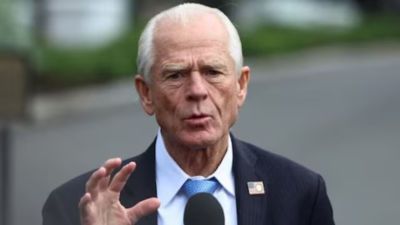Stay updated with the latest - Click here to follow us on Instagram
Orbiting space observatory ready for launch
The multiwavelength astronomy satellite will facilitate simultaneous observations of X-ray and UV spectral bands.
 Prof A R Rao, J S Yadav and K P Singh at TIFR. (Source: Express Photo)
Prof A R Rao, J S Yadav and K P Singh at TIFR. (Source: Express Photo)India’s first space observatory Astrosat, to be launched on September 28, will put the country in the big league with US, Europe, Japan and Russia. A dedicated team has been working behind the scenes for the last 14 years for the country’s first multiwavelength astronomy satellite, which will facilitate simultaneous observations of X-ray and UV spectral bands from celestial bodies. It will help in observing black holes, stars and exploding stars.
“We have had a dedicated team which worked for 14 years to convert an ambitious idea into reality,” said Tata Institute of Fundamental Research (TIFR) Prof A R Rao (61), who has been leading efforts to develop the cadmium-zinc-telluride coded-mask imager.
A successful launch will allow India into the club of nations that have X-ray observatories in orbit, including NASA’s Chandra satellite, the European Space Agency’s XMM-Newton satellite and Italy’s Beppo-Sax satellite.
[related-post]
The 1,650 kg satellite with a 750 kg observatory will carry five astronomy instruments. Three of the major instruments have been designed and developed by TIFR. The project was conceived following the success of the Indian X-Ray Astronomy Experiment, carried on a remote sensing satellite launched in 1996.
ISRO will launch the observatory from Sriharikota. While the idea was voiced in 1997, it crystallised four years later in 2001. Budgeted at Rs 250 crore, the government cleared the project in 2004.
In 2001, Prof Rao started studying specialised detectors in labs. He scouted for new generation solid state X-ray detectors. “I wrote to a company in Israel regarding a detector they were developing and if they can send a sample. We got the equipment and it wasn’t working in India. We went to Israel and talked to them. They fixed it for us and we got it here in the lab. I later made a presentation and said I am confident I will make the detector here,” he said. The CZTI detector, with a mass of 50 kg, will provide position and energy of each absorbed X-ray photon.
An imaging soft X-ray telescope (SXT) with conical foil mirrors, with X-ray Charge Coupled device (CCD) detector in the focal plane, with a total mass of 70 kg, has been developed by a team at TIFR led by Prof K P Singh.
“A lot of research and development was involved and while we got seed money from ISRO, it wasn’t clear in 2001 how to implement the ideas we had. I learned the mirror making technique first, mostly from the Japanese, and set up the lab here to find our own solutions for making mirrors. We built a lot of apparatus in-house and engaged with small, upcoming industries,” said Prof Singh (63).
“The technique was replication of ultra-smooth gold coated glass surface on to aluminium foil, finally acting as an X-ray mirror at grazing incidence,” he added. The telescope took 11 years to develop.
For the camera, a delegation of scientists and engineers from TIFR went to the University of Leicester’s Space Research Centre (SRC) to finalise design elements of an X-ray camera. While TIFR built the main telescope body and mirror, Leicester supported the project through consultancy, and design. The control electronics for SXT was designed and built in TIFR.
“Internationally, our project generated a lot of interest as it has certain features not there in previous satellites. For the first time, we are putting a large bandwidth, from very soft to very hard X-rays. It will have optical, UV and X-ray telescopes, all looking at the same source simultaneously,” said Prof Singh.
He added, “We managed to surprise the international community by building a satellite within a budget of around 40-50 million dollars in comparison to the high budget set abroad, usually 500 to 800 million dollars.”
The three units of large area xenon proportional counters (LAXPC) fabricated by TIFR Prof J S Yadav will be the heaviest payload of 414 kg, with an area of 8000 cm square. When it was first mooted it was a big challenge. No payload of this area has been flown so far.
“The LAXPC sensitivity in 3-100 keV energy range is the highest in the world and will remain so for the next five to 10 years. The idea was first proposed by Prof P C Agarwal who built the Indian X-ray Astronomy Experiment,” said Prof Yadav (59).
The LAXPC is indigenously developed and used technology already available but its highest possible detector sensitivity puts it among the top rung. The detector was ready in 2011 but there were problems with respect to electronics and testing.
The LAXPC Critical Design Review (CDR) was completed only in January 2014 with specifications as initially proposed.
“Hence, it took a lot more time to develop expertise and all three units were delivered in October 2014,” said Prof Yadav.
Prof Yadav said that post launch, the first six months will is when the team expects science data to be generated. “This project gives us confidence that we can do it and am sure with the results we’ll get, there will be more Astrosats,” he added.








